A CTCF-binding site in the Mdm1-Il22-Ifng locus shapes cytokine expression profiles and plays a critical role in early Th1 cell fate specification
- PMID: 38697116
- PMCID: PMC11108081
- DOI: 10.1016/j.immuni.2024.04.007
A CTCF-binding site in the Mdm1-Il22-Ifng locus shapes cytokine expression profiles and plays a critical role in early Th1 cell fate specification
Abstract
Cytokine expression during T cell differentiation is a highly regulated process that involves long-range promoter-enhancer and CTCF-CTCF contacts at cytokine loci. Here, we investigated the impact of dynamic chromatin loop formation within the topologically associating domain (TAD) in regulating the expression of interferon gamma (IFN-γ) and interleukin-22 (IL-22); these cytokine loci are closely located in the genome and are associated with complex enhancer landscapes, which are selectively active in type 1 and type 3 lymphocytes. In situ Hi-C analyses revealed inducible TADs that insulated Ifng and Il22 enhancers during Th1 cell differentiation. Targeted deletion of a 17 bp boundary motif of these TADs imbalanced Th1- and Th17-associated immunity, both in vitro and in vivo, upon Toxoplasma gondii infection. In contrast, this boundary element was dispensable for cytokine regulation in natural killer cells. Our findings suggest that precise cytokine regulation relies on lineage- and developmental stage-specific interactions of 3D chromatin architectures and enhancer landscapes.
Keywords: CBSs; CTCF; Hi-C; Th1; Th17; Toxoplasma gondii; interferon-gamma; interleukin-22; lymphocytic choriomeningitis virus; natural killer cells; super-enhancers; three-dimensional; topologically associating domains.
Published by Elsevier Inc.
Conflict of interest statement
Declaration of interests The authors declare no competing interests.
Figures
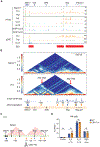
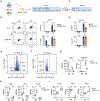
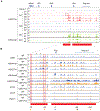
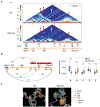

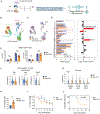
Similar articles
-
CCCTC-binding factor and the transcription factor T-bet orchestrate T helper 1 cell-specific structure and function at the interferon-gamma locus.Immunity. 2009 Oct 16;31(4):551-64. doi: 10.1016/j.immuni.2009.08.021. Epub 2009 Oct 8. Immunity. 2009. PMID: 19818655 Free PMC article.
-
Multiple CTCF sites cooperate with each other to maintain a TAD for enhancer-promoter interaction in the β-globin locus.FASEB J. 2021 Aug;35(8):e21768. doi: 10.1096/fj.202100105RR. FASEB J. 2021. PMID: 34245617
-
Variable Extent of Lineage-Specificity and Developmental Stage-Specificity of Cohesin and CCCTC-Binding Factor Binding Within the Immunoglobulin and T Cell Receptor Loci.Front Immunol. 2018 Mar 8;9:425. doi: 10.3389/fimmu.2018.00425. eCollection 2018. Front Immunol. 2018. PMID: 29593713 Free PMC article.
-
Pushing the TAD boundary: Decoding insulator codes of clustered CTCF sites in 3D genomes.Bioessays. 2024 Oct;46(10):e2400121. doi: 10.1002/bies.202400121. Epub 2024 Aug 21. Bioessays. 2024. PMID: 39169755 Review.
-
The structural and functional roles of CTCF in the regulation of cell type-specific and human disease-associated super-enhancers.Genes Genomics. 2019 Mar;41(3):257-265. doi: 10.1007/s13258-018-0768-z. Epub 2018 Nov 19. Genes Genomics. 2019. PMID: 30456521 Review.
Cited by
-
Super-enhancers in immune system regulation: mechanisms, pathological reprogramming, and therapeutic opportunities.Front Immunol. 2025 Aug 15;16:1652398. doi: 10.3389/fimmu.2025.1652398. eCollection 2025. Front Immunol. 2025. PMID: 40895527 Free PMC article. Review.
-
A PI3Kδ-Foxo1-FasL signaling amplification loop rewires CD4+ T helper cell signaling, differentiation and epigenetic remodeling.bioRxiv [Preprint]. 2024 Nov 2:2024.10.28.620691. doi: 10.1101/2024.10.28.620691. bioRxiv. 2024. PMID: 39803425 Free PMC article. Preprint.
-
Cohesin-mediated chromatin remodeling controls the differentiation and function of conventional dendritic cells.bioRxiv [Preprint]. 2024 Oct 30:2024.09.18.613709. doi: 10.1101/2024.09.18.613709. bioRxiv. 2024. PMID: 39345451 Free PMC article. Preprint.
-
DOCK2 protects against bacterial sepsis by constraining T helper 1 response.Front Immunol. 2025 May 29;16:1527934. doi: 10.3389/fimmu.2025.1527934. eCollection 2025. Front Immunol. 2025. PMID: 40510337 Free PMC article.
-
From Multi-Omics to Visualization and Beyond: Bridging Micro and Macro Insights in CAR-T Cell Therapy.Adv Sci (Weinh). 2025 May;12(20):e2501095. doi: 10.1002/advs.202501095. Epub 2025 May 11. Adv Sci (Weinh). 2025. PMID: 40349154 Free PMC article. Review.
References
Publication types
MeSH terms
Grants and funding
LinkOut - more resources
Full Text Sources
Molecular Biology Databases
Research Materials

